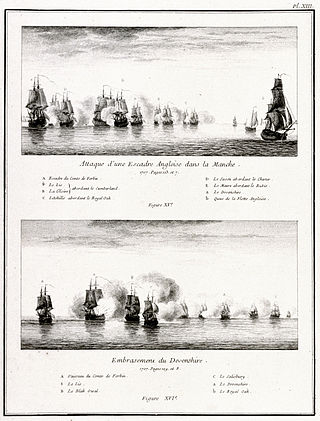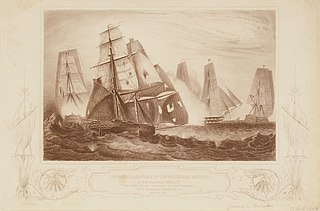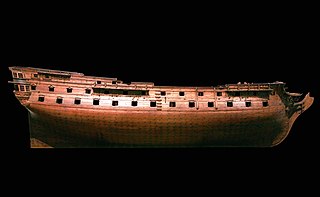
Claude, comte de Forbin-Gardanne was a French naval officer, nobleman and diplomat. From 1685 to 1688, he led a diplomatic mission to the Ayutthaya Kingdom. He became governor of Bangkok and a general in the Siamese army, and left Siam shortly before King Narai fell ill and was deposed by a coup d'état.

The action of 3 July 1810 was a minor naval engagement of the Napoleonic Wars, in which a French frigate squadron under Guy-Victor Duperré attacked and defeated a convoy of Honourable East India Company East Indiamen near the Comoros Islands. During the engagement the British convoy resisted strongly and suffered heavy casualties but two ships were eventually forced to surrender. These were the British flagship Windham, which held off the French squadron to allow the surviving ship Astell to escape, and Ceylon. The engagement was the third successful French attack on an Indian Ocean convoy in just over a year, the French frigates being part of a squadron operating from the Île de France under Commodore Jacques Hamelin.

The naval Battle of the Lizard took place on 21 October 1707 during the War of the Spanish Succession near Lizard Point, Cornwall between two French squadrons under René Duguay-Trouin and Claude de Forbin and an English convoy protected by a squadron under Commodore Richard Edwards.

The Battle of Fort Royal was a naval battle fought off Fort Royal, Martinique in the West Indies during the Anglo-French War on 29 April 1781, between fleets of the British Royal Navy and the French Navy. After an engagement lasting four hours, the British squadron under Admiral Samuel Hood broke off and retreated. Admiral de Grasse offered a desultory chase before seeing the French convoys safe to port.
Edward Acton was a captain in the Royal Navy, distinguished for services in the reign of Queen Anne.

HMS Salisbury was a 50-gun fourth rate ship of the line of the Royal Navy, built by Richard and James Herring at Baileys Hard on the Beaulieu River in Hampshire, England and launched on 18 April 1698.

HMS Hampton Court was a 70-gun third rate ship of the line of the Royal Navy, launched at Deptford Dockyard in 1678. Her initial commission was to move her to Chatham where she spent in the next ten years in Ordinary. She held an active commission for the War of the English Succession, participating in the Battles of Beachy Head and Barfleur. She was rebuilt at Blackwall in 1699/1701. During the War of Spanish Succession she served mainly in the Mediterranean. In 1707 she was taken by the French and incorporated into the French Navy for four years. She was sold to the Spanish in 1712. She was wrecked in Spanish service off the coast of Florida in a hurricane in 1715.
HMS Grafton was a 70-gun third rate built at Woolwich Dockyard in 1677/79. She was delivered to Chatham and placed in Ordinary in 1679. She was commissioned in 1683 to participate in the evacuation of Tangier, Morocco. She served during the War of the English Succession fighting in the Battles of Beachy Head and Barfleur. She was rebuilt in 1699/1701. She was in active commission during the War of Spanish Succession. She fought in the Battle of Vigo, the capture of Gibraltar and the Battle of Velez Malaga. She was taken by the French in 1707 and incorporated into the French Navy. Finally, being broken at Brest in 1744.

D'Hautpoul was a Téméraire class 74-gun French Navy ship of the line launched at Lorient on 2 September 1807. She was previously named Alcide and Courageux.

Captain Seth Jermy (1653–1724) was an officer of the Royal Navy, famous for fighting a particularly hard-fought action against an overwhelming French force while commander of HMS Nightingale.

The Vengeur was a 64-gun ship of the line of the French Navy designed by Antoine Groignard. She saw action with Bailli de Suffren during the American War of Independence.

The action of 8 January 1780 was a naval encounter off Cape Finisterre between a British Royal Naval fleet under Admiral Sir George Rodney, and a fleet of Spanish merchants sailing in convoy with seven warships of the Caracas Company, under the command of Commodore Don Juan Augustin de Yardi. During the action the entire Spanish convoy was captured. Rodney's fleet was en route to relieve Gibraltar, and this action took place several days before Rodney's engagement and defeat of a Spanish fleet at the Battle of Cape St. Vincent.
HMS Montreal was a 32-gun Niger-class fifth-rate frigate of the Royal Navy. She was launched in 1761 and served in the Seven Years' War and the American War of Independence. The French captured her in 1779 and she then served with them under the name Montréal. An Anglo-Spanish force destroyed her during the occupation of Toulon early in the French Revolutionary Wars.
The action of 4 September 1782 was a small naval engagement fought off the Île de Batz between a French naval frigate, Hébé, and a Royal Naval frigate, HMS Rainbow. This battle was notable as the first proper use of a carronade, and so effective was this weapon that the French commander promptly surrendered just after the first broadside.

The action of 24 February 1780 was a minor naval battle that took place off the island of Madeira during the American Revolutionary war. A French convoy was intercepted and pursued by a British Royal Navy squadron ending with the French 64-gun ship Protée being captured along with three transports.
The Battle of the Levant Convoy was a naval engagement of the French Revolutionary Wars fought on 7 October 1795. During the battle, a powerful French squadron surprised a valuable British convoy from the Levant off Cape St Vincent on the coast of Portugal. The convoy was weakly defended, and although the small escort squadron tried to drive the French back, they were outmatched. In the ensuing action one of the British ships of the line and almost the entire convoy was overrun and captured. The French commander, Commodore Joseph de Richery, then retired to the neutral Spanish port of Cádiz, where he came under blockade.

Ganteaume's expedition of 1795 was a French naval operation in the Aegean Sea in the autumn of 1795 during the French Revolutionary Wars. Commanded by Commodore Honoré Ganteaume in the ship of the line Républicain, with a squadron of four frigates and two corvettes, the French force was ordered to attack First Coalition shipping in the Aegean Sea. The principal target was the Ottoman city of Smyrna, the most significant trading port of the region, Ganteaume ordered to prey on merchant shipping sailing for European destinations and in particular a large convoy due to sail to Britain.

Richery's expedition was a French naval operation during 1795 and 1796 as part of the French Revolutionary Wars. The operation was led by Commodore Joseph de Richery and comprised two separate cruises; the first was an operation off Cádiz in Southern Spain in which Richery attacked and defeated a large British merchant convoy with a weak escort, taking many prizes. Forced to anchor at Cádiz, the French squadron was subsequently blockaded in the port for almost a year. Richery was enabled to escape in August 1796 by a Spanish fleet, and went on to attack British fisheries off Newfoundland and Labrador before returning to France having inflicted severe damage to British Atlantic trade.
Monarch was built at Quebec in 1800. She sailed to England, being captured and recaptured shortly before arriving. In England, under new ownership, she proceeded to make five voyages for the British East India Company (EIC) as an "extra ship", that is, under voyage charter. In 1813 she became a transport, and then in 1818 or so a regular merchantman. She was broken up in 1820.
François-Aymar de Monteil was a French Navy officer. He served in the War of American Independence, earning membership in the Society of the Cincinnati. He was also a member and director of the Académie de Marine.













